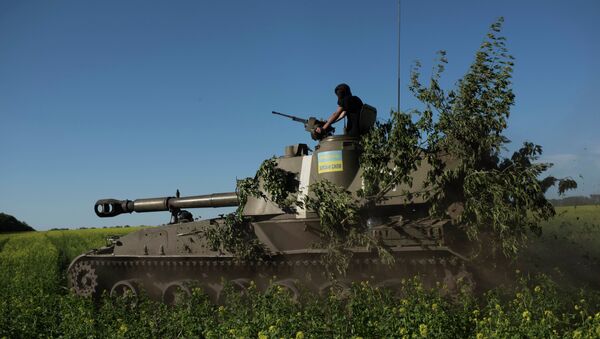On November 20 last year, Kuwait’s Interior Ministry announced the arrest of a local criminal group, who supplied Daesh with weapons from Ukraine.
However, the scandal over Ukraine’s defense industry is connected not only to those whom Kiev sells the arms to, but to the quality as well.
What is the Ukrainian military industry all about?
In the wake of the 1991 breakup of the Soviet Union, Ukraine inherited from the USSR one of the biggest military-iindustrial complexes, employing over 3 million people at more than 3,000 enterprises across the republic.
Twenty-four years later a mere 140 such enterprises are still at work.
The Ukrobotonprom concern was established in 2010 as an umbrella for 134 arms making enterprises, along with state arms exporter Ukrspetsexport.
With the outbreak of the armed conflict in Donbass more than 30 such enterprises were commissioned to repair damaged military hardware and build new units.
The bulk of Ukraine’s military output was traditionally sold abroad and this situation hardly changed even with the start of the civil war in eastern Ukraine.
According to Ukroboronprom’s CEO Roman Romanov, in 2015 the concern’s portfolio of export contracts amounted to $1.3 billion, even though, according to the Stockholm International Peace Research Institute (SIPRI), it was $323 million less than in 2014.
Cannibalized tanks
Tanks and fighting vehicles top the list of Ukrainian arms exports. Ten Oplot-T tanks arrived in Thailand on May 21, in addition to this number supplied earlier. The Thais are still unhappy because they expected 49 such tanks to arrive already three years ago.
Ukrainians have also failed to supply enough ammunition for the Oplots whose quality leaves much to be desired. Small wonder because the Oplot-T tanks being supplied to Thailand are just a cannibalized version of the old Soviet T-80 main battle tank.
According to Ukrainian media reports, there are hundreds of T-80 engines currently available in the country, which is more than enough to install on the remaining 29 Oplots the Thais are still waiting for.
Just how long these tanks will run after such an overhaul is anybody’s guess though.
Like car thieves do
On July 7, 2013, Ukrspetsexport was commissioned by Croatia to repair and upgrade seven MiG-21 fighter jets and supply five new ones. After receiving 13 million euros from the Croatian defense ministry Ukraine supplied the jets in 2014. Before very long the planes began to fall apart and eight months later only three were able to get off the ground.
An official probe by Croatian military police revealed that the Ukrainians had installed used parts on the planes they claimed to have repaired, and stamped new serial numbers on the old engines they installed on the allegedly “new” MiGs (just like car thieves usually do.)
Ukrspetsexport customarily dismissed the charges as part of what it called “an information war.”
Limp Bucephaluses
In 2009, Ukrspetsexport was contracted to supply 420 Bucephalus armored vehicles to Iraq.
Widely trumpeted by Kiev as being “fully in line with NATO standards,” the Bucephalus fighting vehicle was proudly declared to be “steps streets ahead” of its Russian analogues.
By 2013, a mere 88 such units had been delivered. Moreover, the Iraqis sent back an additional 42 Bucephaluses with numerous cracks in their armor and canceled the deal altogether.
According to Iraqi media reports, 80 percent of the Ukrainian-supplied armored vehicles had broken down already before 2013 was out.
Kiev traditionally blamed Russia, with the director of Ukraine’s Da Vinci AG analytical group, Anatoly Baronin accusing Russian intelligence of being behind the cancellation of the lucrative contract.
Ambitions without borders
In 2015, Ukrainian President Petro Poroshenko set the country an ambitious task of joining the club of the world’s top five arms exporters.
According to SIPRI, in 2010-2014 Ukraine accounted for 3 percent of the global arms exports, the target looked pretty real.
The problem isn’t however, that a lion’s share of those exports consisted of decades-old weapons and parts Ukraine had inherited from the Soviet Union.
Even before the 2014 “Maidan revolution” the head of the Verhovna Rada’s defense and security committee Anatoly Kinakh admitted that weapons developed and built in post-Soviet Ukraine accounted for less than 20 percent of its exports.
The scope of the technological degradation of Ukraine’s military-industrial complex is so large that the country failed to launch the production of engines for its T-64 main battle tank.
With the old hardware that can still be sold now quickly running out, Ukrainian arms exporters are now facing stiff competition with the ongoing conflict in Donbass, which is eating up the bulk of what the country’s struggling military-industrial complex can offer.





